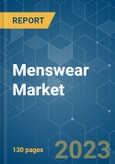Men these days are very up-to-date about their appearance and fashion. The consciousness of fashion and clothing around the world is increasing. For every occasion, there is a different outfit for men these days. An increase in e-commerce websites, affordable clothing, and the increased purchasing power of consumers are driving the market. The market players adopt different strategies to attract consumers, such as offering promotional discounts, casting celebrities in their advertisements, and having festive sales. In addition, companies are developing new shopping experiences for consumers to provide them with the finest shopping experience possible. For instance, in May 2022, H&M launched a new in-store shopping experience enabled by technology in the United States. This in-store shopping experience provides consumers with personalized recommendations, fast checkout, seamless payment, and upgraded delivery or return options.
The adoption of a luxury lifestyle among consumers has influenced the purchasing power of millennials to opt for luxury wear. People tend to spend on fashion wear, party wear, and even nightwear. Rapid growth and rising urbanization lead to a modern class of consumers with more money to spend who develop a growing passion for current fashion. The demand for occasion-specific clothing is growing within the menswear segment. Over the long term, the digitalization of online shopping apps, increased spending power, and awareness of clothing among men are expected to drive the market.
Menswear Market Trends
Growing Inclination for Online Shopping Among Men
A boost in exposure to the internet and e-commerce has improved fashion consciousness and the availability of high-end brands and rare products. Over the past few years, the companies have been targeting men’s wear due to growing purchasing power in emerging economies, including China and India. The rising influence of media and marketing strategies adopted by e-commerce platforms, such as celebrity endorsements, promotional discounts, and festive sales, is anticipated to fuel the market's growth in the coming years. Moreover, with the increasing number of online users, there has been a steady rise in online transactions and the average amount of money spent online. The users are ready to buy the goods on the spot due to online retail's ease, convenience, and time-saving advantages. Many luxury brands are forming partnerships with technology companies to enhance people's shopping experiences. For instance, in February 2022, LMVH Japan and SoftBank Corp. signed a partnership agreement. This agreement enhanced the online sales of LMVH with the help of the expertise of SoftBank Corp. in digitalization. The increased security features offered by online retailers, such as online payments, free delivery, improved online customer services, and the more customer-friendly design of shopping websites like Amazon, Myntra, Flipkart, and many more, influence customers to shop online.Asia-Pacific to Experience Robust Growth in the Menswear Market
The menswear industry has witnessed significant growth in recent years in China and India. This is because male shoppers tend to focus on quality and style, purchasing high-quality garments. According to data from the Indian Ministry of External Affairs, in 2021, the country had 1.3 billion people with an average age of 29. Due to the young population, the men's wear market is growing. The young generation these days is influenced by fashion models and actors. They want their wardrobe to be versatile and fashionable. In India, there are multiple festivals for which men need different attire. Indian brands are forming partnerships with famous designers to enhance the quality and fashion of men's wear. For instance, in February 2021, Aditya Birla Fashion and Retail formed a partnership with Tarun Tahilani, India's top designer, to enter the market for men's premium ethnic clothing.Moreover, the rapid growth of China’s economy, increasing purchasing power among China’s urban middle-class customers, brand awareness, and demand for apparel quality drive the Chinese menswear market. The future of online shopping for men will continue to grow, owing to an increase in consumer acceptance of the internet as an alternative shopping channel. Given this fact, the menswear market will increasingly become competitive. The new millennial generation of Asian-Pacific men will be the key drivers for both European and American influences in menswear.
Menswear Market Competitor Analysis
The menswear market is highly competitive. Some major key global players in the menswear market include Gap Inc., Aditya Birla Management Corporation Pvt. Ltd., Kering, Burberry Group PLC, Reebok, Adidas, Nike, and Inditex (Zara), among others. All these players are trying different innovative marketing strategies to enhance the market value of their products. Some of the companies are forming mergers and acquisitions with foreign and local brands in the region to expand their portfolio. All of these players are expected to remain active in the global men's wear market as it grows.Additional benefits of purchasing the report:
- The market estimate (ME) sheet in Excel format
- 3 months of analyst support
This product will be delivered within 2 business days.
Table of Contents
Companies Mentioned (Partial List)
A selection of companies mentioned in this report includes, but is not limited to:
- Gap Inc.
- Aditya Birla Management Corporation Pvt. Ltd
- Industria de Diseño Textil, S.A.
- Kering SA
- Nike Inc.
- PVH Corp.
- Adidas AG
- Burberry Group PLC
- Hermès International S.A.
- H & M Hennes & Mauritz AB
- LVMH Moët Hennessy Louis Vuitton










